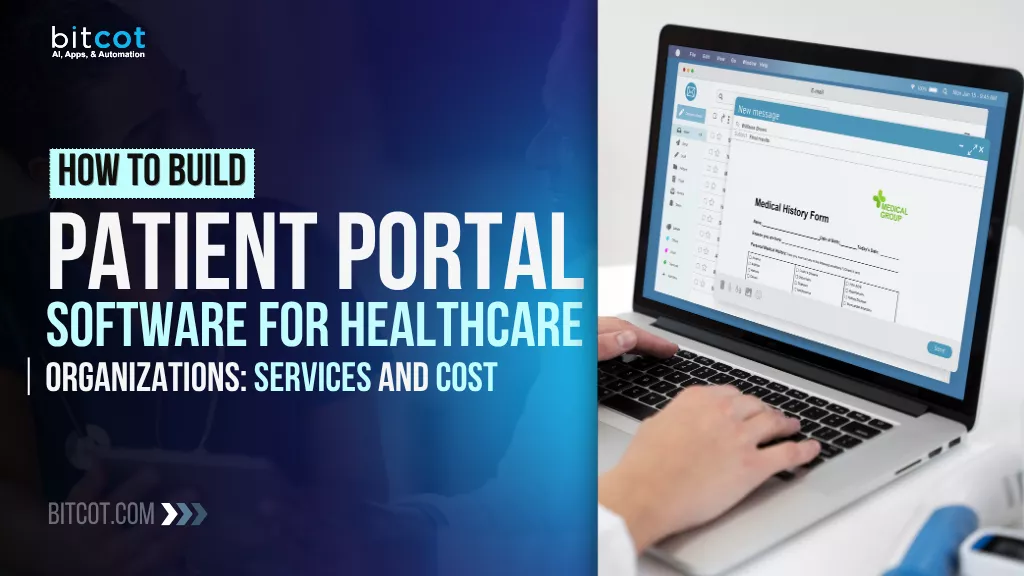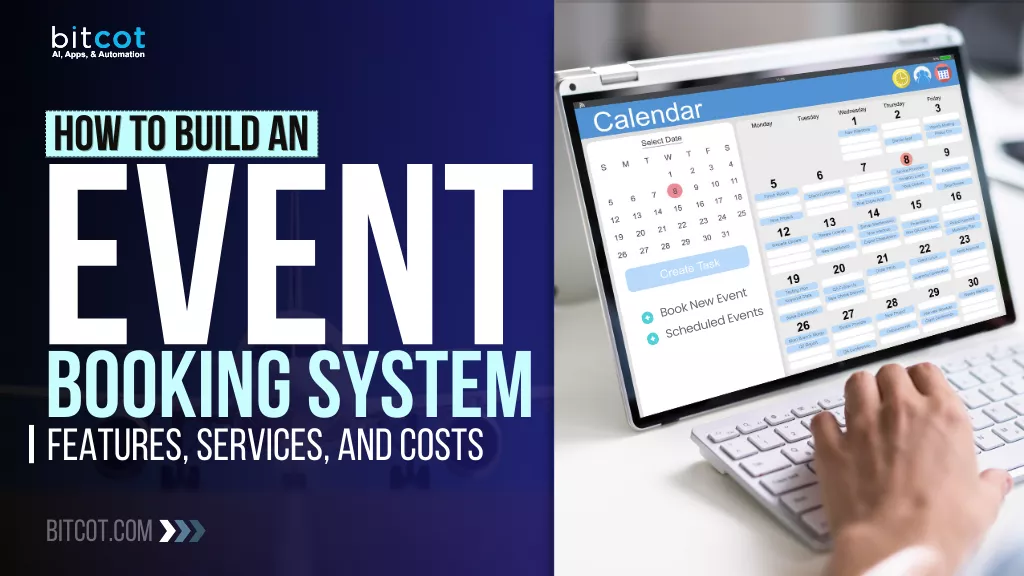
Your patients expect seamless, secure, and convenient access to their healthcare information, anytime, anywhere.
But if your systems aren’t integrated, every interaction becomes a hassle. Your team spends unnecessary time navigating multiple platforms, while patients struggle with disjointed experiences.
Sound familiar?
Today’s patients demand easy access to their health data, appointment scheduling, and communication with their care teams, all at the touch of a button. If your healthcare organization can’t keep up, you risk losing patient trust and satisfaction.
In this post, we will explore the practical steps to build patient portal software for healthcare organizations, covering essential services, features, and cost considerations.
You’ll gain clear insights and a step-by-step roadmap to help you build a patient portal that enhances the patient experience while streamlining your internal processes.
Ask yourself:
- How much time do patients spend waiting for updates on their medical records?
- How often do they struggle to find a direct communication channel with their doctors?
- You know these challenges all too well, but where do you stand in addressing them?
Whether you’re a healthcare provider, a project manager, or part of an IT team, building an effective patient portal is a critical step towards improving care delivery.
Patient portal software is transforming healthcare communication, connecting patients to the right information, reducing administrative burdens, and fostering a better overall patient experience.
At Bitcot, we specialize in designing and developing custom patient portals that cater to the unique needs of healthcare organizations. We help you create secure, user-friendly portals that improve both patient engagement and operational efficiency.
The future of healthcare communication is here. Are you ready to provide it?
Key Features of an Effective Patient Portal Software
When building a patient portal, it’s crucial to include the right set of features that enhance both the user experience and the efficiency of healthcare operations.
A well-designed portal should offer a seamless interface for patients and healthcare professionals alike, ensuring secure communication and easy access to essential services.
Here’s a breakdown of the must-have features for your patient portal:
1. Secure Login & Authentication
Security is paramount in healthcare, and your patient portal must have robust authentication measures to protect sensitive data. This includes secure login methods, such as multi-factor authentication (MFA), to ensure only authorized users can access the portal.
2. Appointment Scheduling & Reminders
A convenient scheduling system allows patients to book, reschedule, or cancel appointments at their convenience. Automated reminders via email or SMS can reduce no-show rates and keep patients on track with their appointments.
3. Access to Medical Records & Lab Results
One of the primary reasons patients use portals is to access their medical records and lab results. Offering an intuitive interface where patients can easily view test results, diagnoses, prescriptions, and visit summaries fosters transparency and empowers patients to take charge of their health.
4. Direct Messaging with Healthcare Providers
A secure messaging system enables patients to communicate directly with their doctors or care team, asking questions, clarifying instructions, or discussing treatment options. This eliminates the need for lengthy phone calls or waiting for in-person visits.
5. Prescription Management
Patients should be able to view their current prescriptions, request refills, and track medication history. Integrating with pharmacies can streamline this process and improve patient adherence to prescribed treatments.
6. Billing & Payment Features
Simplified billing systems allow patients to view their statements, make payments online, and access financial support or insurance claims. A clear, transparent billing system reduces confusion and frustration for both patients and staff.
7. Health Tracking & Reporting
Enabling patients to track their health data, such as blood pressure, glucose levels, or weight, can be a valuable feature, particularly for patients with chronic conditions. Health tracking features also give healthcare providers insights into their patients’ ongoing health status between visits. Advanced patient monitoring software can further enhance this capability by enabling continuous remote monitoring and real-time data analysis.
8. Patient Education Resources
A library of educational materials, such as articles, videos, and FAQs, can help patients better understand their conditions, treatment options, and wellness strategies. Providing this resource through the portal gives patients the tools they need to make informed decisions.
9. Telemedicine Integration
As telehealth becomes more prominent, integrating virtual visits directly into your patient portal can provide patients with a seamless experience. This feature allows for video consultations, follow-up appointments, and remote monitoring from the same platform they use for scheduling and messaging. Reliable telemedicine software integration ensures smooth communication and enhances the virtual care experience.
10. User-Friendly Interface
Above all, your portal must be easy to use. With a simple, intuitive interface, even patients who aren’t tech-savvy should be able to navigate the portal with ease. The goal is to eliminate frustration and encourage frequent usage.
How to Build Patient Portal Software for Healthcare Organizations
Building a patient portal for your healthcare organization isn’t just about developing software; it’s about creating a secure, user-friendly, and efficient tool that improves patient care and enhances operational efficiency. Below are the essential steps to take from concept to launch.
1. Define Your Goals & Requirements
Before diving into development, it’s critical to clearly define what you want your patient portal to achieve. Ask yourself questions like:
- What problems are you aiming to solve for your patients?
- What features are essential for your specific healthcare setting (e.g., specialty clinics, hospitals, private practices)?
- How will you ensure compliance with healthcare regulations like HIPAA (Health Insurance Portability and Accountability Act) and GDPR (General Data Protection Regulation)?
Work closely with your healthcare team to identify needs, pain points, and desired functionalities. This step will serve as the blueprint for your portal and guide all future decisions. Consider how healthcare digital transformation strategies can help you reimagine patient engagement and care delivery.
2. Select the Right Technology Stack
Choosing the right technology stack is crucial for the functionality, scalability, and security of your patient portal. Key considerations include:
- Frontend Development: Use modern frameworks like React, Angular, or Vue.js to build an intuitive, responsive interface.
- Backend Development: Technologies like Node.js, Python (Django/Flask), or Ruby on Rails are popular for developing robust back-end systems that manage data and integrate with other healthcare software.
- Database: Choose a secure, HIPAA-compliant database like MySQL, PostgreSQL, or MongoDB to store patient data.
- Cloud Hosting: Platforms like AWS, Azure, or Google Cloud offer secure cloud services that scale with your organization’s growth.
Security must be a top priority, so opt for tools and frameworks that prioritize encryption and data protection. Professional healthcare web design and development services can ensure your portal is built on a solid technical foundation.
3. Design the User Experience (UX)
User experience (UX) is the key to creating a portal patients will actually use. Work with designers to create a simple, clean interface that guides users through the process of accessing their health information, scheduling appointments, and communicating with their healthcare team.
Some UX design tips:
- Keep it intuitive: A straightforward layout and easy-to-navigate menu structure will ensure that even non-technical users can find what they need.
- Mobile-first design: Many patients will access the portal from smartphones, so ensure it’s fully optimized for mobile use.
- Accessibility: Make sure the portal is accessible for all patients, including those with disabilities. Follow WCAG (Web Content Accessibility Guidelines) to ensure a universally accessible design.
4. Develop & Integrate Core Features
With your goals, technology stack, and design in place, it’s time to start development. Focus on creating a scalable solution that can grow with your organization’s needs. Here’s what you’ll need to integrate:
- Secure login and authentication: As mentioned earlier, multi-factor authentication (MFA) and role-based access control (RBAC) will ensure that only authorized individuals can access sensitive information.
- Healthcare system integrations: Your portal must integrate with your existing Electronic Health Records (EHR) system, practice management software, and billing systems to provide a unified experience for both patients and healthcare providers. Comprehensive EHR/EMR integration ensures seamless data flow across all platforms.
- APIs for external services: Consider integrating third-party services like pharmacy systems, telemedicine platforms, or insurance verification tools through APIs to provide additional functionality.
Keep in mind that integration is a complex process and requires careful planning to avoid disrupting existing workflows. Medical device integration may also be necessary if your organization uses connected medical devices for patient monitoring.
5. Test for Security & Compliance
Once development is underway, rigorous testing is essential to ensure that your portal meets security standards and complies with healthcare regulations like HIPAA, HITECH, and other local data protection laws. Perform comprehensive testing, including:
- Penetration testing: Identify any vulnerabilities that could be exploited by malicious actors.
- Data encryption: Ensure all patient data is encrypted in transit and at rest.
- Compliance audits: Work with legal and compliance experts to verify that your portal meets all relevant regulations.
Testing for usability is equally important; ensure patients can easily access and navigate the portal, and that healthcare providers can quickly update and retrieve necessary information.
6. Launch & Monitor
After finalizing the portal, it’s time to roll it out. Start with a soft launch, offering the portal to a select group of patients and healthcare providers. Gather feedback on usability, performance, and any issues that arise. Use this feedback to fine-tune the portal before a full-scale launch.
Once live, ongoing monitoring is critical to ensure that the portal remains secure, functional, and user-friendly. Set up performance monitoring tools to track uptime, load times, and user engagement metrics. Additionally, continue gathering user feedback to iterate on the portal and introduce new features over time.
7. Provide Ongoing Support & Maintenance
A patient portal is a dynamic product that requires continuous updates and support. Regularly update the portal to add new features, fix bugs, and ensure compatibility with evolving healthcare standards. It’s also important to provide patient and staff support to address any technical issues or user concerns.
Invest in training healthcare staff to fully utilize the portal’s features, ensuring they can answer patient queries and leverage the portal to streamline their workflows. Implementing healthcare automation can further optimize administrative tasks and improve operational efficiency.
Cost Factors for Building Patient Portal Software for Healthcare Organizations
Building a patient portal involves various costs, depending on the features, complexity, and scale of the system you want to implement. While it’s tempting to focus on the immediate price tag, it’s essential to think about the long-term investment and the return on investment (ROI) the portal can provide.
Here’s a breakdown of the main factors that will influence the cost of developing your patient portal.
1. Scope & Complexity of Features
The more features you want to include, the higher the development costs. Here are a few categories to consider:
- Basic Features: If you’re building a simple portal with appointment scheduling, access to medical records, and messaging, the cost will be lower.
- Advanced Features: Features like telemedicine integration, prescription management, billing systems, health tracking, and robust reporting dashboards require more development time and resources. Incorporating AI imaging solutions can add significant diagnostic capabilities but may increase development costs.
- Customizations: If you need highly specialized features tailored to your specific healthcare organization (e.g., unique workflows, complex integration with EHR systems), expect to pay more.
As a rough estimate:
- Basic portals can cost $20,000-$50,000.
- More feature-rich systems may range from $50,000-$150,000+, depending on complexity.
2. Design & User Experience (UX)
The user experience is critical, especially in healthcare. Designing a seamless, intuitive portal takes time and expertise. Good UX design ensures the portal is patient-friendly and can help reduce training costs down the line.
A custom UX design typically costs between $5,000-$15,000, depending on the level of customization and the number of screens and user flows that need to be created.
3. Technology & Platform Selection
The choice of technology stack also impacts the cost. Open-source technologies may reduce upfront development costs, but they may require more customization and maintenance in the long run. On the other hand, proprietary platforms or cloud-based solutions may have licensing or subscription fees that add to the ongoing costs.
The development stack, whether you go with custom development or use a ready-made solution, will influence the overall pricing. Some organizations may opt for Software-as-a-Service (SaaS) patient portal solutions, which often have lower upfront costs but come with recurring monthly or annual fees.
Custom development might start at $50,000-$100,000 for initial build-out, with additional costs for integration, hosting, and maintenance.
4. Integration with EHR, CRM, and Other Systems
One of the most significant costs in building a patient portal is integration. If your healthcare organization uses Electronic Health Records (EHR) systems or Customer Relationship Management (CRM) tools, the portal will need to communicate with these existing platforms. Integration can be time-consuming, especially if your systems are outdated or have custom configurations.
Costs for system integration can vary widely, depending on:
- The number and complexity of systems to integrate with.
- The level of support required from your existing software providers.
- Whether you need to use APIs or build custom connectors.
Integration typically costs between $10,000-$50,000, depending on the number of systems involved and the complexity of the integration. Implementing RPA in healthcare can help automate repetitive integration tasks and reduce long-term operational costs.
5. Security & Compliance
Healthcare data is highly sensitive, so building a HIPAA-compliant, secure patient portal is a non-negotiable requirement. The cost of ensuring the system meets strict regulatory standards, including encryption, secure data storage, and access controls, can be significant.
Some additional costs to consider:
- Security Features: Multi-factor authentication, role-based access controls, and encryption require specialized development and testing.
- Compliance Audits: You may need to hire third-party experts to perform security audits and ensure the portal complies with all healthcare regulations.
Budget for $10,000-$30,000 for ensuring compliance and implementing strong security features.
6. Ongoing Maintenance & Support
Like any software, your patient portal will need continuous updates, patches, and support to ensure everything runs smoothly. Maintenance includes:
- Regular updates: Adding new features or making changes to comply with evolving regulations.
- Security patches: Keeping the system up-to-date with the latest security fixes.
- Bug fixes: Addressing issues as they arise.
Maintenance and support can range from 10%-20% of the initial development cost per year. For example, if you spend $100,000 on development, you can expect to pay $10,000-$20,000 annually for ongoing maintenance and updates.
7. User Training & Adoption
Once the portal is ready, you’ll need to train both patients and healthcare staff to use it effectively. While training for patients may be minimal (considering the user-friendly design), your healthcare staff may need more extensive training on how to integrate the portal into their daily workflows.
Training costs can vary:
- Staff Training: Depending on the number of users, this could cost $5,000-$20,000.
- Patient Support: If you plan on offering customer support for patients to help them navigate the portal, you’ll need to allocate resources for call centers, online guides, and FAQs. This may add another $5,000-$15,000 in the first year.
The initial development costs are just one part of the equation. Over time, you’ll need to factor in ongoing costs for maintenance, updates, and support, which can add up.
However, investing in a patient portal has significant long-term benefits. By improving patient engagement, reducing administrative workloads, and enhancing communication, your portal can drive efficiency, improve patient satisfaction, and increase revenue through streamlined billing and care coordination.
Core Services Offered in Patient Portal Software Development
When selecting a development partner for your patient portal project, it’s essential to understand the core services they offer.
The right partner should provide a comprehensive set of services that cover every aspect of the portal’s lifecycle, from initial planning and design to post-launch support.
Below are the key services you should expect from a full-service development team:
1. Consulting & Strategy Development
The first step in building a patient portal is understanding your specific needs and goals. A reliable development partner will begin with a thorough discovery phase, where they assess your current systems, workflows, and patient engagement challenges.
From there, they will work with you to develop a strategic roadmap for the portal that aligns with your business objectives and regulatory requirements.
Services to expect:
- Stakeholder interviews and user research to understand needs.
- Assessment of existing systems (EHR, CRM, billing, etc.).
- Roadmap development for short-term and long-term goals.
- Regulatory and compliance advice (HIPAA, GDPR, etc.).
2. UX/UI Design
Designing a patient portal that is intuitive and easy to use is crucial for ensuring adoption. Your development partner should offer professional UX/UI design services to create a portal that patients and healthcare staff can easily navigate. This process includes wireframing, prototyping, and designing a visually appealing and user-friendly interface that adheres to healthcare accessibility standards.
Services to expect:
- User journey mapping and personas development.
- Wireframes, mockups, and high-fidelity designs.
- Mobile-first, responsive design for all devices.
- Accessibility compliance with WCAG (Web Content Accessibility Guidelines).
3. Custom Development & Integration
Custom development is often necessary to meet the unique requirements of your healthcare organization. Your development partner should have the expertise to build tailored solutions that address your specific needs, whether that’s a custom appointment booking system, a telemedicine platform integration, or specialized data management features.
Services to expect:
- Custom portal feature development (appointment scheduling, messaging, health tracking, etc.).
- Integration with third-party systems (EHR, CRM, telemedicine, pharmacies).
- API development for data exchange between systems.
- Seamless synchronization of patient data across platforms.
Using AI agents in healthcare can make your portal smarter by automating tasks like booking appointments, checking symptoms, and giving personalized health tips.
4. Security & Compliance Implementation
Ensuring the security of patient data is not only a legal requirement but also essential for maintaining trust. A reputable development partner should help you implement strong security protocols and ensure the portal meets all necessary regulatory standards (e.g., HIPAA, HITECH, GDPR). This includes encrypting sensitive data, implementing access controls, and conducting security audits.
Services to expect:
- End-to-end encryption (in transit and at rest) for data security.
- Multi-factor authentication (MFA) for secure logins.
- Role-based access control (RBAC) to limit user permissions.
- Regular security audits and vulnerability testing.
- Compliance consulting to ensure adherence to healthcare regulations.
5. Cloud Hosting & Infrastructure Management
A patient portal requires a reliable, scalable, and secure cloud infrastructure to handle large amounts of sensitive data. Your development partner should offer cloud hosting services, including infrastructure setup, server management, and performance optimization. Cloud hosting provides the flexibility to scale your portal as your organization grows.
Services to expect:
- Cloud hosting solutions (e.g., AWS, Azure, Google Cloud).
- Data backup and disaster recovery planning.
- Continuous monitoring for performance optimization and uptime.
- Load balancing to manage traffic spikes during peak hours.
6. Testing & Quality Assurance
Before launching the portal, rigorous testing is essential to ensure it works flawlessly. Your development partner should conduct thorough testing across all features and functionalities to identify and fix bugs, improve user experience, and ensure the system performs as expected. This includes functional testing, security testing, and user acceptance testing (UAT).
Services to expect:
- Functional testing for all core features (appointments, messaging, records access).
- Usability testing with real users (patients, healthcare providers).
- Security testing to identify vulnerabilities.
- Load and performance testing to ensure scalability.
7. Launch & Deployment
Once your portal is developed and tested, the launch phase is critical to ensuring everything goes smoothly. Your development partner should help with the deployment of the portal, ensuring a seamless rollout. This includes migrating data, setting up necessary server environments, and ensuring all integrations are live and functional.
Services to expect:
- Final deployment of the portal to the production environment.
- Data migration from legacy systems (if applicable).
- Real-time monitoring during launch to address any issues.
- Stakeholder training for your team on how to use the portal.
8. Training & Support
A successful patient portal requires that both your healthcare staff and your patients understand how to use it effectively. Your development partner should offer training services to ensure all users are comfortable navigating the portal. Ongoing support services should also be available to address any technical issues, fix bugs, or make updates as needed.
Services to expect:
- Staff training on how to use the portal for day-to-day operations.
- Patient education materials and guides on how to use the portal.
- Ongoing technical support (helpdesk, bug fixes, performance updates).
- Regular software updates to improve functionality and compliance.
9. Post-Launch Maintenance & Updates
Building and launching a patient portal is just the beginning. To ensure the portal remains effective, secure, and compliant, ongoing maintenance is essential. Your development partner should provide post-launch support that includes regular updates, security patches, and the addition of new features based on user feedback.
Services to expect:
- Ongoing software updates and bug fixes.
- Security patches to address emerging vulnerabilities.
- New feature development based on user feedback.
- System monitoring and performance optimizations.
When selecting a development partner, look for a company that offers a full suite of services from initial consultation and strategy development to post-launch maintenance and support.
A comprehensive approach ensures that your patient portal is not only functional and secure but also aligns with your long-term goals for patient engagement, operational efficiency, and regulatory compliance.
Partner with Bitcot to Build Your Custom Patient Portal Software
When building a custom patient portal, selecting the right development partner is key to success. Bitcot specializes in delivering secure, user-friendly, and scalable patient portal solutions tailored to healthcare organizations.
Here’s why Bitcot is the right choice:
- Healthcare Expertise: We bring years of experience in developing HIPAA-compliant solutions, working with healthcare systems, and understanding the complexities of patient data management.
- User-Centered Design: Our team designs intuitive and accessible interfaces that ensure both patients and healthcare providers can easily navigate the portal, improving engagement and user adoption.
- End-to-End Services: We provide comprehensive services from initial consultation and design to development, system integration, and post-launch support, ensuring a seamless process from start to finish.
- Security & Compliance: Data security is our top priority. We build HIPAA-compliant portals with robust encryption, authentication, and role-based access controls to protect sensitive patient information.
- Seamless Integration: We ensure your portal integrates smoothly with existing healthcare systems like EHR, CRM, billing platforms, and telemedicine solutions, streamlining your operations.
- Ongoing Support: Our commitment doesn’t end at launch. We offer continuous maintenance, software updates, and technical support to ensure your portal remains secure, efficient, and up-to-date.
Partner with Bitcot for a custom patient portal that enhances patient care, boosts operational efficiency, and provides a secure, user-friendly experience for both patients and healthcare professionals.
Final Thoughts
Building a custom patient portal is a big step toward improving your healthcare operations and patient care.
But it’s also a long-term investment that requires careful planning, the right tools, and an experienced team.
Whether you’re focused on enhancing patient engagement, improving operational efficiency, or ensuring compliance, a well-built portal can make all the difference.
Choosing the right development partner, like Bitcot, is essential for turning your vision into reality. With our expertise in healthcare solutions and custom software development, we’ll ensure that your portal not only meets the needs of your patients and providers but also stands the test of time.
If you’re ready to take the next step toward a more connected, secure, and user-friendly patient experience, Bitcot is here to help. Our custom healthcare software development services are designed to give you a tailored, HIPAA-compliant portal that streamlines care and communication.
Ready to build your custom patient portal?
Let’s chat and bring your vision to life. Reach out to Bitcot today!












